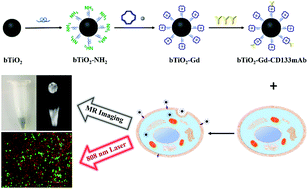当前位置:
X-MOL 学术
›
Biomater. Sci.
›
论文详情
Our official English website, www.x-mol.net, welcomes your feedback! (Note: you will need to create a separate account there.)
Black TiO2-based nanoprobes for T1-weighted MRI-guided photothermal therapy in CD133 high expressed pancreatic cancer stem-like cells†
Biomaterials Science ( IF 6.6 ) Pub Date : 2018-06-12 00:00:00 , DOI: 10.1039/c8bm00454d Siqi Wang 1, 2, 3, 4, 5 , Wenzhi Ren 4, 5, 6, 7, 8 , Jianhua Wang 1, 2, 3, 4, 5 , Zhenqi Jiang 4, 5, 6, 7, 8 , Madiha Saeed 4, 5, 6, 7, 8 , Lili Zhang 5, 8, 9, 10, 11 , Aiguo Li 5, 8, 9, 10, 11 , Aiguo Wu 4, 5, 6, 7, 8
Biomaterials Science ( IF 6.6 ) Pub Date : 2018-06-12 00:00:00 , DOI: 10.1039/c8bm00454d Siqi Wang 1, 2, 3, 4, 5 , Wenzhi Ren 4, 5, 6, 7, 8 , Jianhua Wang 1, 2, 3, 4, 5 , Zhenqi Jiang 4, 5, 6, 7, 8 , Madiha Saeed 4, 5, 6, 7, 8 , Lili Zhang 5, 8, 9, 10, 11 , Aiguo Li 5, 8, 9, 10, 11 , Aiguo Wu 4, 5, 6, 7, 8
Affiliation

|
At present, transmembrane glycoprotein CD133 highly expressed pancreatic cancer stem cells (PCSCs), with the features of chemotherapeutic/radiotherapeutic resistance and exclusive tumorigenic potential, are considered as the primary cause of metastasis and recurrence in pancreatic cancer, and therefore are an effective target in the disease treatment. Furthermore, with the launch of precision medicine, multifunctional nanoprobes have been applied as an efficient strategy for the magnetic resonance imaging (MRI)-guided photothermal therapy (PTT) of pancreatic cancer. In this research, with the aim of achieving precise MRI-guided PTT in CD133 highly expressed PCSCs, novel bTiO2-Gd-CD133mAb nanoprobes were designed and successfully prepared by loading Gd-DOTA and CD133 monoclonal antibodies on black TiO2 nanoparticles. It was very interesting to find that the r1 relaxivity value of the nanoprobes was 34.394 mM−1 s−1, about 7.5 times that of commercial Magnevist (4.5624 mM−1 s−1), which indicates that the nanoprobes have good potential as MRI T1 contrast agents with excellent performance. Herein, CD133 highly expressed PANC-1 cells were selected and verified as PCSCs model. In vitro experiments demonstrated that the nanoprobes exhibited active-targeting ability in PANC-1 cells, and consequently could specially enhance T1-weighted MR imaging and 808 nm near-infrared (NIR)-triggered PTT efficiency in the PCSCs model. Our study not only provides a new strategy for the effective treatment of pancreatic cancer and its’ stem cells, but also further broadens the application of black TiO2 in the field of cancer theranostics.
中文翻译:

黑色TiO 2基纳米探针,用于CD 1高表达胰腺癌干样细胞中T 1加权MRI引导的光热疗法†
目前,跨膜糖蛋白CD133高表达的胰腺癌干细胞(PCSCs)具有化疗/放疗耐药性和独特的致癌潜力,被认为是胰腺癌转移和复发的主要原因,因此是胰腺癌的有效靶点。疾病的治疗。此外,随着精密医学的推出,多功能纳米探针已被用作胰腺癌磁共振成像(MRI)指导的光热疗法(PTT)的有效策略。在这项研究中,为了在CD133高表达的PCSC中实现精确的MRI引导的PTT,设计并通过在黑色TiO上加载Gd-DOTA和CD133单克隆抗体,成功设计并成功制备了新型bTiO 2 -Gd-CD133mAb纳米探针。2个纳米粒子。有趣的是,纳米探针的r 1弛豫值为34.394 mM -1 s -1,约为商品Magnevist(4.5624 mM -1 s -1)的7.5倍,这表明纳米探针具有良好的潜力。 MRI T 1造影剂具有出色的性能。在此,选择CD133高表达的PANC-1细胞并验证为PCSCs模型。体外实验表明,纳米探针在PANC-1细胞中具有主动靶向能力,因此可以特异性增强T 1。PCSCs模型中的MR加权成像和808 nm近红外(NIR)触发的PTT效率。我们的研究不仅为胰腺癌及其干细胞的有效治疗提供了新的策略,而且进一步拓宽了黑色TiO 2在癌症治疗学领域的应用。
更新日期:2018-06-12
中文翻译:

黑色TiO 2基纳米探针,用于CD 1高表达胰腺癌干样细胞中T 1加权MRI引导的光热疗法†
目前,跨膜糖蛋白CD133高表达的胰腺癌干细胞(PCSCs)具有化疗/放疗耐药性和独特的致癌潜力,被认为是胰腺癌转移和复发的主要原因,因此是胰腺癌的有效靶点。疾病的治疗。此外,随着精密医学的推出,多功能纳米探针已被用作胰腺癌磁共振成像(MRI)指导的光热疗法(PTT)的有效策略。在这项研究中,为了在CD133高表达的PCSC中实现精确的MRI引导的PTT,设计并通过在黑色TiO上加载Gd-DOTA和CD133单克隆抗体,成功设计并成功制备了新型bTiO 2 -Gd-CD133mAb纳米探针。2个纳米粒子。有趣的是,纳米探针的r 1弛豫值为34.394 mM -1 s -1,约为商品Magnevist(4.5624 mM -1 s -1)的7.5倍,这表明纳米探针具有良好的潜力。 MRI T 1造影剂具有出色的性能。在此,选择CD133高表达的PANC-1细胞并验证为PCSCs模型。体外实验表明,纳米探针在PANC-1细胞中具有主动靶向能力,因此可以特异性增强T 1。PCSCs模型中的MR加权成像和808 nm近红外(NIR)触发的PTT效率。我们的研究不仅为胰腺癌及其干细胞的有效治疗提供了新的策略,而且进一步拓宽了黑色TiO 2在癌症治疗学领域的应用。

























 京公网安备 11010802027423号
京公网安备 11010802027423号